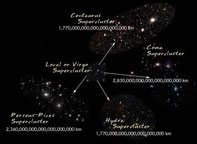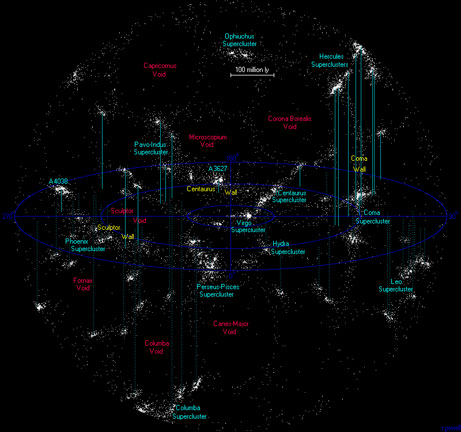
The Nearest Superclusters
About the Image
Galaxy Superclusters usually consist of chains of around a dozen galaxy clusters, each with a mass of about ~ 1013 - 1014 solar masses. The largest superclusters can be spread over several million light years of space. Ninety percent of galaxies are thought to be located in them!

The supercluster images on the Nearest Supercluster pages are not photos of the superclusters themselves. Each supercluster is represented by images of the major clusters within it, as noted below. Please note that many of these images have foreground stars from our galaxy in them.
Virgo Supercluster: This is our Local Supercluster - it is called the Virgo Supercluster because it is dominated by the Virgo Galaxy Cluster. The cluster that is next richest in galaxies is the Fornax Cluster. For more information on the Virgo Cluster, see the Local Supercluster page.
Coma Supercluster: The two major galaxy clusters that dominate here are the Coma Cluster (Abell 1656) and the Leo Cluster (Abell 1367). The Coma Cluster image is copyright Duncan A. Forbes (Swinburne University, Australia). The Leo Cluster image is from the STScI Digitized Sky Survey.
Hydra Supercluster: The only galaxy-rich cluster in the Hydra Supercluster, is the Hydra Cluster (Abell 1060). It contains a similar number of galaxies to the Virgo Cluster. There are other smaller clusters too - the richest of these is the Antlia Cluster. The images of the Hydra and Antlia Clusters used were from the STScI Digitized Sky Survey.
Centaurus Supercluster: Because the plane of our own Galaxy cuts across the region of the sky that the Centaurus Supercluster is in, any images of galaxy clusters within it will have nearby foreground stars in it. The dominant cluster here is the Centaurus Cluster (Abell 3526); the image of it is from the STScI Digitized Sky Survey.
Perseus-Pices Supercluster: The Perseus-Pisces supercluster is made up of many galaxy clusters which form a long, dense wall which stretches almost 300 million light years. At one end of it is the Perseus Cluster (Abell 426), which is one of the most massive galaxy clusters within 500 million years of us. (This cluster is being used representatively on the Nearest Superclusters page.) Because of its structure, the Perseus-Pices Supercluster is perhaps the most obvious supercluster in the sky. It also lies near what is perhaps the most obvious void in the sky, called the Taurus Void. The Taurus void, 100 million light years in diameter, is large and circular, with walls of galaxies on either side of it. There are a few galaxies in it, however. Atlas of the Universe has a STScI Digitized Sky Survey image of two of the galaxies in this void, UGC2627 and UGC2629, which are 185 million light years away.

A really good reference with good maps of the nearest superclusters and voids are the Atlas of the Universe pages: The Nearest Superclusters and The Neighboring Superclusters. The following is one of the diagrams from this excellent site, which was created by Richard Powell.
Distance Information
It is hard to give an exact distance for a supercluster, because the galaxy clusters within it are often millions of light years from each other!
The Hydra Supercluster is about 100 million light years long, and the galaxy clusters within it range from about 105 to 160 million light years away from us.
The Coma Supercluster is about 300 million light years away from us - its two main galaxy clusters, Coma and Leo, are about 305 and 290 million light years away, respectively. 300 million light years is 2,838,000,000,000,000,000,000 km.
The clusters within the Centaurus Supercluster range from around 140 to 200 million light years away from us.
The Perseus-Pices Supercluster is about 300 million light years long and the clusters within it are around 180 to 240 million light years away!
How Do We Calculate Distances of This Magnitude?
When we speak of the distances to things like galaxies that are very, very far away (millions of light years), we often speak of their redshifts. Galaxies emit light. Light comes in different wavelengths. Splitting the light from a galaxy with a prism, we can observe its spectrum. The visible spectrum of a typical galaxy appears as a broad band of light at most wavelengths, with some dark absorption lines on top. These absorption lines occur at very specific wavelengths or "colors"; they are set by abundant gas (including hydrogen) within the galaxy.
If a galaxy is moving away from us, the "colors" of the absorption lines that we see here on Earth get shifted toward the longer, red wavelengths of light. This is what we call redshift. If a galaxy is moving towards us, its spectrum becomes bluer, or blueshifted.
The velocity with which a galaxy moves away from us is proportional to its distance from us. The farther an object is from us, the faster it is moving away!
This is called Hubble's Law, after Edwin Hubble, who, in 1925, serendipitously discovered that all galaxies are moving away from us. Hubble's law tells us that recessional velocity (or the rate an object is moving away from us) is equal to the Hubble Constant times distance. This means if we can measure the recessional velocity of an object, determined by its redshift, we can determine its distance. The Hubble method can be used to find distances of astronomical objects out to the limits of the observable Universe.
The constant in Hubble's Law, however, is uncertain (by perhaps a factor of 2), so distance measurements are similarly uncertain.
For more information on the Hubble Constant, please see: http://csep1.phy.ornl.gov/guidry/violence/hubble_constant.html
Why Are These Distances Important To Astronomers?
We are far enough out from our home planet at this distance, that we can start to see how the Universe is structured. We are a small part of a much larger picture than an early scientist like Aristotle could have imagined. Our planet is part of a solar system, which is in a star system, which is in an outer arm of a galaxy, which is part of a cluster of galaxies, which is part of a supercluster of galaxies. Now we can see that these superclusters of galaxies are distributed, not uniformly across space, but in filiments, sheets, and walls, interspersed with large, nearly empty voids. When we zoom out more, we'll have an even better picture of the large-scale structures that make up the Universe.
Travel Time
If we traveled at 17.3 km/sec, it would take 5,200,000,000,000 years to get to the Coma Supercluster. If we could travel at the speed of light, it would take 300 million years to arrive!



